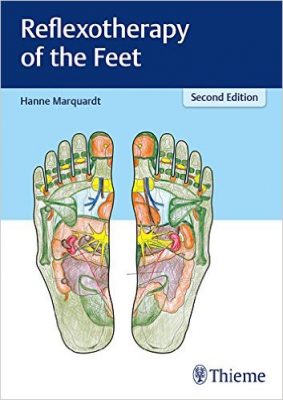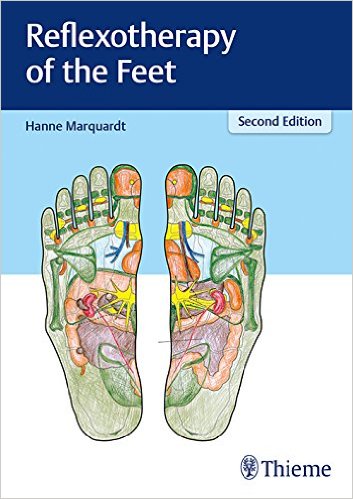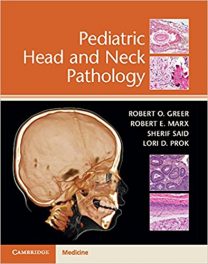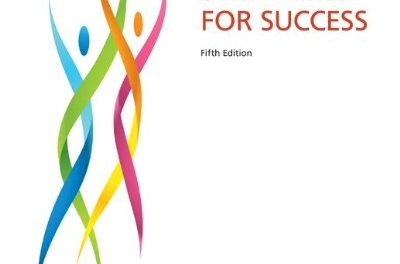 Author: Hanne Marquardt, RN
Author: Hanne Marquardt, RN
Publisher: Thieme – 224 pages
Book Review by: Sonu Chandiram
According to the Gale Encyclopedia of Alternative Medicine, reflexology (also called ‘reflexotherapy’ is “a therapeutic method of relieving pain by stimulating predefined pressure points on the feet and hands. This controlled pressure alleviates the source of the discomfort. In the absence of any particular malady or abnormality, reflexology may be as effective for promoting good health and for preventing illness as it may be for relieving symptoms of stress , injury, and illness (italics ours).
It goes further to state: Reflexologists work from maps of predefined pressure points that are located on the hands and feet. These pressure points are reputed to connect directly through the nervous system and affect the bodily organs and glands. The reflexologist manipulates the pressure points according to specific techniques of reflexology therapy. By means of this touching therapy, any part of the body that is the source of pain, illness, or potential debility can be strengthened through the application of pressure at the respective foot or hand location.
This book – Reflexotherapy of the Feet – is now in its second edition, which typically signifies that the first edition was well received by readers and possibly was a financial success for the publisher. It has been written by a registered nurse who has been practicing and teaching this method of relieving and alleviating pain and pressure for a very long time: read about her work at the bottom of this review.
A large amount of content has been packed into this book of 224 pages. There are 32 chapters in this relatively short book as compared to typically lengthy medical textbooks. The average chapter length is about seven pages. We provide below as an overview the titles of its four Parts:
- Part I – General Principles
- Part II – Practical Part
- Part III – Special Topics and Further Developments
- Part IV – Appendix
The above outline does not reveal much about this book’s contents. But this 12-point Summary of the Method in the last chapter tells you in a nutshell what reflexotherapy of the feet (referred to in short as RTF) is about:
- In its practical application, from a theoretical perspective and as a result of the similarity in shape between the foot and a seated person, reflexotherapy of the feet is easily understandable and can easily be learned.
- It is more than a local foot massage because, as a microsystem, the feet are in constant interaction with the whole system.
- It enables personal access to the person through work with the hands and hence conveys the important “remedy of touch.”
- It can be combined with all of the methods from the medical-therapeutic sector and in particular, trains the eye with regard to the effectiveness of simplicity.
- Its results are convincing as the effects and changes can be experienced both spontaneously during treatment and in the outcome in the course of treatment
- It directly addresses the regenerative and vital forces of the sick because it avoids technical aids and substitutes.
- It is cost-saving and economical in use as it does not suppress the symptom but also includes the background causes.
- It conveys the realistic expectation that pain does not have t be fought like an enemy but can also offer the opportunity for change.
- Depending on the occupational profile, it can be used as a therapeutic tool and / or for health care and maintenance, and, depending on the profession, as an aid to diagnosis.
- It can be offered to all age groups for many acute and chronic diseases, on its own or as an adjunctive therapy.
- It subordinates itself to important laws f life because it employs the principles of rhythm and dynamism in the therapeutic grip.
- It creates contented patients and therapists as the shared experience of treatment results directly in substantial and constructive life contexts.
This second edition of the book provides the fundamentals as well as recent developments on the subject. Here are some important features in this new edition:
- Examination of the question what are the reflex zones of the foot?
- Reflex zones of the lymphatic system
- Tooth zones and their energetic relationships
- Facial zones and their therapeutic connections
- Reflex zones of the pelvic tendons and ligaments
- Connection between reflex zones and meridians
- New grip techniques
Books on reflexotherapy are rare, and this excellent and extensive one on the feet not only fills a needed gap but also does it very well on it as a science and as an art, with detailed information in textual and illustrative forms.
Author:
Hanne Marquardt, RN, a registered nurse and naturopath, is a pioneer in teaching and practicing Reflexotherapy. For almost 60 years she has trained around 80,000 therapists and set up 18 training centers around the globe. The founding practice is situated in Konigsfeldt-Burgberg, Germany.







